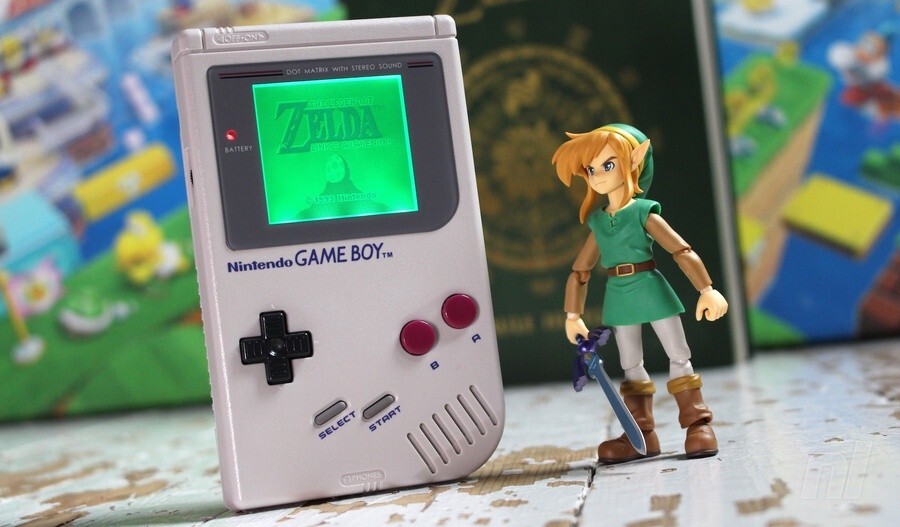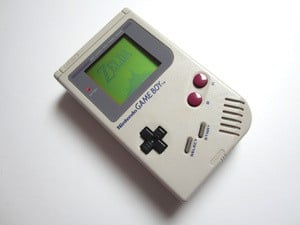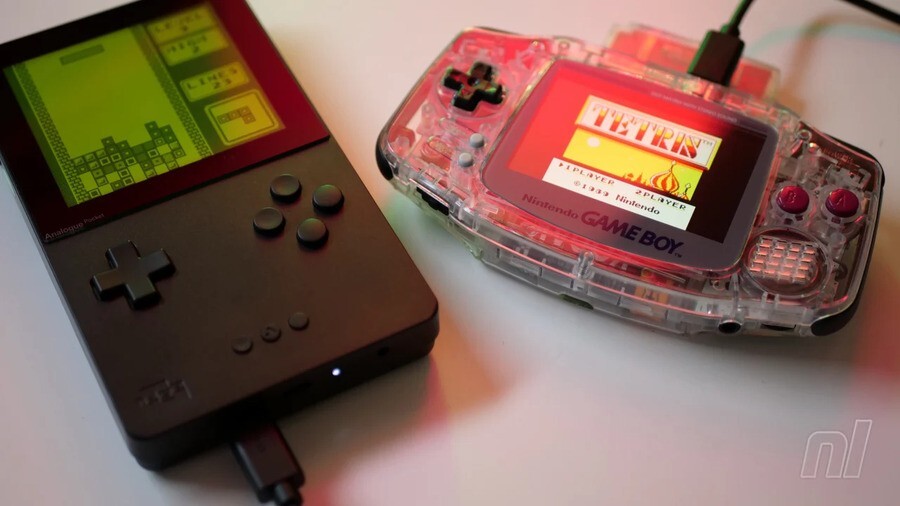
The Game Boy is an iconic piece of gaming hardware, but the quest to elevate and celebrate its games has continued over the course of more than 30 years. Backwards compatibility with the later Game Boy line enabled us all to replay the OG library on updated, improved screens and the quest to present 8-bit retro classics at their very best continues to this day.
The sought-after Analogue Pocket is the latest all-singing, all-dancing handheld to wow retro gamers with its lovely screen — it's amazing what difference a good panel can make to a portable game, so today we're looking back and remembering the varying ways we've viewed the Game Boy's classic library over the years...
[Not So] Humble Beginnings
Nintendo’s original Game Boy was — miraculously — an instant success, and would go on to sell over 64 million units worldwide. To put that in context the humble Game Boy outsold the NES, SNES, N64, GameCube, SEGA Genesis / Mega Drive, Xbox One, and plenty more. And that’s only counting the sales it rang up at tills around the world before the advent of the Game Boy Color extended family, long before the end of the handheld’s supported life.
Not bad for a device sporting a low resolution 160x144 dot matrix screen capable of displaying just four shades of sludgy grey/green and measuring a mere 6cm on the diagonal, is it?

Greatness Out Of The Green
The phenomenal success of the handheld naturally encouraged developers big and small to not only get on board the Nintendo train but stay there. Talented artists and programmers spent huge amounts of time working within the hardware’s limitations, creating glorious tech-defying showcases that pushed the Game Boy to make what was once unimaginable look easy, from the enormous and intricate pixel art bosses found in Gradius: The Interstellar Assault to the sci-fi wireframe 3D of the virtually-impossible-to-Google X.
When Game Boy titles graphically push the envelope they’re bursting with character and impressive detail, whether they’re taking Link on a dreamy adventure around Koholint Island in Link’s Awakening, or used as part of a remake (or demake, if you prefer) port of Neo Geo arcade classic Samurai Shodown.
Regardless of its age, the best Game Boy art still looks good.
Cheaping Out
The slightest in-game movement sent streaks of green sliding around the screen, making the platforming challenges in launch title Super Mario Land far more difficult than they really were.
Unfortunately, while developers were working hard to make minor miracles a reality Nintendo… was not. Considering the original Game Boy’s advanced age — it’ll turn thirty-three this year — and its utter domination of the commercial and cultural sides of portable gaming since forever, it’s easy to assume that the technology found within the familiar grey brick was the very best the late '80s could offer; that, for all its faults, asking for anything better would have been foolish. And that’s simply not true.
Atari’s Lynx as well as Sega’s Game Gear both released shortly after Nintendo’s portable, both had full colour backlit displays, and both outperformed the Game Boy with little effort; the former powerful enough to handle sprite scaling straight out of the box (the year before the SNES released), and the latter pretty much a portable Master System — a capable 8-bit console that was only a few years old at the time. With a simple shop-bought adapter Game Gear owners could even directly play home cartridges on the thing. In fairness, the image on Sega's handheld was still mightily blurry in motion, too, but the backlight and colour made it easier on the eyes.

In comparison the Game Boy had two major strengths. It was cheap to run thanks to the extended lifespan of its four AA batteries, and it was also (comparatively) cheap to buy. It was cheap to buy because it was cheap to make.
And you could tell, even at the time. The original screen was, to not put too fine a point on it, a smeary mess — when the room was bright enough to see it, that is. The slightest in-game movement sent streaks of green sliding around the screen, making the platforming challenges in launch title Super Mario Land far more difficult than they really were.
It arguably spoiled many a good action game and in a strange twist perhaps even passively helped the likes of Pokémon do well, if only because the largely static battle graphics meant people could actually see it. Forgotten drawers and neon-coloured bum bags (known as ‘fanny packs’ in certain parts of the world) are still stuffed full of the worm lights and screen magnifiers we needed to make playing on old Game Boys tolerable.
Modern Solutions To Retro Problems
For a long time the only solutions were to either grin and bear it, upgrade your Game Boy to a newer model — although even then the Game Boy Advance SP’s front and backlit variants came with their own fresh set of drawbacks and compromises — or give up and play through an emulator, which tended to be fine but not so much fun.
Until relatively recently, that is. New ports of old games (think Konami’s Castlevania and Contra packs, as well as Square-Enix’s Collection of Mana) now tend to come with high quality screen filters that optionally give us the Game Boy look we always wish we’d had. Crisp olive-tinted grids of clearly defined pixels used to make the art — once hidden behind retro 'blur' — look as fantastic now as they should have done the first time around.
unleashed from its original restraints the Game Boy’s unmistakable 8-bit style isn’t just 'tolerable', it’s beautiful
But even as good as they can look, these filters are at best only scratching the surface, and are subject to the developer having the time, money, and tech to make the magic happen. Why wait for someone else to make a port (and then hope it’s a decent one), when you can create the Game Boy experience you always wanted for yourself? Original hardware is now easily modified and fitted with bright IPS screens to give incredible viewing experiences with the minimal amount of fuss (and expense).
For those who wish to go even further, the sharpest pixels and multiple display modes present on the show-stopping (and wallet-busting) FPGA-powered, LTPS LCD-equipped Analogue Pocket allow you to pick and choose exactly how you want your games to look, across a wider range of emulated hardware than any official Game Boy ever supported. It may have taken decades, but we finally have devices that truly do justice to the art that was always there.
When unleashed from its original restraints the Game Boy’s unmistakable 8-bit style isn’t just 'tolerable', it’s beautiful, and can be clearly seen echoed in brand new releases like Thunder Striker and the rest of Pixel Game Maker Series’ ‘Game Buddy’ offerings — and also found in true new games for the old hardware such as Tales Of Monsterland. In both of these cases, the style is not just appreciated but chosen, the strict limitations challenging creativity to flourish under tightly focused circumstances. You see it all the time with modern 8-bit NES-style throwbacks like Shovel Knight or the upcoming Infernax, but it's less common with the OG Game Boy aesthetic and we're very happy to see these projects keeping the style alive.

Thanks to new approaches to ageing hardware, plus easy access to a whole range of Game Boy compatible devices and technical modifications capable of making the experience sweeter than it has ever been, there’s still plenty of life and gamer interest in Nintendo’s company-saving handheld and its catalogue of classics. It may be 2022, but somehow the future — and the screen — has never looked brighter for Nintendo’s oldest handheld.
Green or grey, smeared or sharp — how do you like your Game Boy games to look, and what do you like to play them on? Let us know in the usual place.
Further reading:




Comments 25
It's worth mentioning that with a bivert mod including a green backlight, the original Game Boy's screen can look razor sharp and clear while still retaining that green and grey quality.
It's a bit of a tricky mod to do DIY, but for those serious about mono GB games on original hardware who like to be able to see what they're doing, it's worth paying out for a pre-modded unit.
While I love the aesthetic for GB games, some games with fast scrolling looked like smeared mustard, back in the day. Mario Land jumps out as an example, in my mind. I really would like to see more games with this aesthetic, though. Perhaps with a more pleasing palette than the green one though.
I think the GBA has top-tier pixel art. Games on that system just look so good
'Dot martix with stereo sound'. Sounded like something from the future in 1989! Would be great to see more original GB emulation on Switch. The Konami Collections did a really good job representing the screen. Super Mario Land on Switch with that M2 emulation would be great, I miss the VC. Still, have a good GB collection on my 2DS XL at least.
I personally just like playing these games as they’re output, without filters. The green makes my eyes water so I prefer the black and white versions. Whereas I’ll play any other console with a CRT filter!
Cool article! Warms my heart my favorite console is still getting this much love. ♥️
Game boy games still look incredible today. Link's awakening on switch looks exactly like I remember it, and it's a simple upscaling with a slightly enhanced colour palette.
I've got a bunch of modded or restored Gameboy models and the Color and Advance are not used at all for playing the monochrome titles.
For me, the Funny Playing IPS mod for the Gameboy Pocket (as well as the equivalent for the DMG-01) is probably the best authentic and mostly-original hardware experience for playing Gameboy games. The retro pixel mode almost nails the look.
The second best handheld experience would be with the classic backlit mod, IMO.
Recently I've also been enjoying playing with the Super Gameboy. There's some nostalgia for the SGB enhancements and border - and the R5X LCD scanline option is strangely compelling 😊
I can't be the only one who had finished Super Mario Land within a day as a child?
I like the way gb/gbc games look on the 3DS virtual console. It looks good on a bigger screen, but I also like the pixel by pixel one with the fake gb/gbc border. On a 3DS XL it's basically the same screen size you'd get on a regular game boy.
@dok5555555 Yep, I always use that dot by dot mode too, it looks really good on the 2DS XL.
@KingMike
Different game but I beat Mario bros ds in one day as a kid. And no I am not ashamed of it.
@KingMike Nice. I was 4 when I got that game though, so it took me a tad longer than one day.
The OG Game Boy was the first handheld I ever had, but I can safely say the Game Boy Advance is the handheld that I have the fondest memories of.
@blindsquarel NSMB DS was pretty easy, until world 8 which kicked my butt seriously.
There are monochrome Game Boy games that have astoundingly lovely pixel art, that is almost as if everything was done pixel by pixel. Games like Wario Land 1, Kid Dracula, World Heroes 2 Jet, Parodius, and even the Game Boy camera.
In some cases, it almost feels like developers had a mind to show off what they could do with limited hardware. Handheld gaming was definitely better because of it ❤
I recently picked up a Gameboy DMG01 with 5 games and manuals and one was Kid Dracula!
Picked it up for a bargain.
Been playing it a fair bit but my old eyes can't handle the green screen like they used to so I'm going to mod it using the IPS mod to give it a nice sharp screen.
Keeping everything else original though.
@StarPoint
yeah i loved how a lot of GBA games looked, the only downside i would say is due to how there was no backlight originally a lot of games had this washed out look which didn't translate so well when played on something which did have a backlight.
@Mgalens Yeah, I guess I didn't experience the games on original hardware. Playing it through an emulator looks fantastic, though.
@KingMike
To be fair I was 7 but yeah the whole series is super easy.
@StarPoint
the issue with washed out visuals definitely is something which can vary from game to game, it was something used so players could see the game better on the original GBA screen which is why some games can look like the contrast is turned way up.
still has some really nice looking games and im glad were starting to get some gba collections (castlevania advance collection, megaman zero etc) would be awesome to see golden sun get a collection.
Just get a Playdate, it's the modern retro solution.
I love the Game Boy aesthetic, it's so distinct. Nothing else looks like Game Boy games, it's kind of like watching cartoons made in the 1930's.
MOLE MANIA THUMBNAIL!!!!!!!!!!!!!!!!!!!!!!!!!!!!
@Muddy_4_Ever I love a bit of Mole Mania myself
Show Comments
Leave A Comment
Hold on there, you need to login to post a comment...